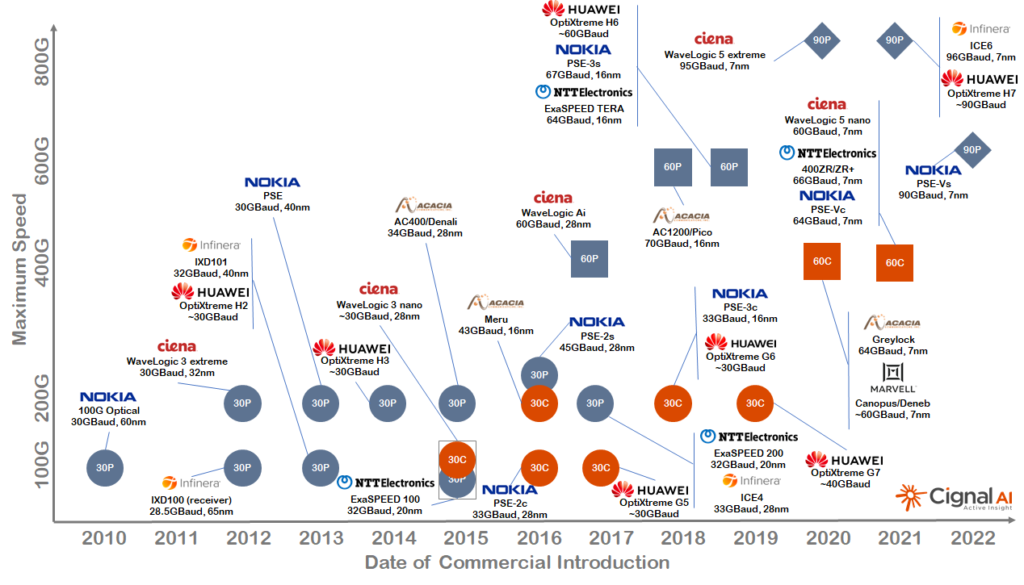
Historically, the telecommunications industry has referred to the emerging generations of coherent optical technology as “Gen1” to “Gen5”, but that nomenclature does not sufficiently distinguish the variety of capabilities available today. As pluggable coherent (e.g., 400ZR/ZR+) takes hold, the direction of coherent development has split significantly, with one path focused on maximum performance and the other on reduced power and cost for compact deployment.
A singular Gen number does not do service to this important distinction. Therefore, Cignal AI will now recognize and classify coherent DSP technology by its maximum baud rate and define whether the DSP is optimized for (P)erformance track or (C)ompact applications. Doing so is a much cleaner and more accurate system for grouping DSPs with similar performance into clearly defined generations.
This change is logical because:
- Continuing the path of Gen1 through Gen5 is not a viable option, since low power DSPs like 400ZR do not fit cleanly into the established pattern. Consequently, each vendor interprets Gen4, Gen 5, and future generations differently, creating a lack of consistency.
- Maximum data rate (speed) is also not a good way to track DSP generations, as coherent DSPs are usually operated at speeds below their maximum. Some DSP manufacturers have acknowledged this fact by eliminating the highest speed modes to save size and power (e.g., 60GBaud 200Gbps optics in China, Nokia’s PSE-Vs with a top speed of 600Gbps).
- The original high-performance 400Gbps DSPs are a distinctly different generation from today’s 400ZR/ZR+ pluggables. The original 400Gbps DSPs were designed to integrate into optical systems and provide short-reach 400Gbps operation and long-distance 200Gbps operation. The 400ZR/ZR+ generations are primarily focused on pluggability, especially for IP-over-DWDM operation in which the coherent module plugs directly into a switch or router. Nomenclature that acknowledges the different foci of these technologies is therefore required.
- Baud rate[1] is the best indicator of a coherent system’s capability, since higher baud rate translates directly to longer reach, higher maximum data rate, and optimized spectral efficiency. The performance of 60GBaud high performance coherent optical engines was matched a few years later by a 60GBaud compact solution. The industry needs a clear way to indicate that these are effectively the same generation of optics, but each with a different focus.
Generations Defined
As shown in the table below, coherent generations are now separated into 30GBaud, 60GBaud, 90GBaud, and 120GBaud generations based on the maximum baud rate capable of the DSP. In general, the baud rates are the minimum for that generation. Therefore, a DSP with a baud rate of 45GBaud would fall into the Gen30 column.
Within each generation, solutions are classified as either Performance or Compact. Performance solutions are historically the first to be developed and focus on the longest reach possible. Compact solutions typically follow Performance solutions by several years and focus on reducing size and power – usually for deployment in a standard client format (CFP/CFP2/QSFP-DD).

Coherent DSP roadmaps follow a pattern with an initial release of a specific speed/baud rate in a Performance form factor followed some years later by a Compact version. The Compact version is usually (but not always) developed in a smaller silicon process size that enables lower power and size. By separating the generations into two tracks (performance and compact), the progression is easily identified.

Generations in Historical Context
In the diagram below, DSPs from coherent vendors are plotted on a timeline against maximum speed. The dates shown are when the solutions were made commercially available. Note that component vendors (e.g., NTT Electronics) define commercial availability as the first shipment of a DSP to an equipment vendor, while vertically integrated systems vendors (e.g., Ciena) define commercial availability as the first shipment to an end customer. Therefore, stated dates within a year of each other become somewhat inconsequential; more important are the overall trends.

Single wavelength Gen30P solutions took several years to mature as they expanded from large, 100Gbps solutions to more efficient and powerful 200Gbps solutions (for clarity, earlier dual-wavelength and lower speed 30GBaud solutions are not included in this chart). Compact solutions using the same baud rates but in smaller form factors appeared about 5 years after the first performance solutions arrived. That separation of time shrank to 3 years for Gen60 solutions, and it is expected to be even shorter for upcoming Gen120 solutions due to the OIF 800Gbps Implementation Agreement currently under development. The separation is much easier to visualize with this generation definition.
Updated Cignal AI Documents and Reports
Given all these examples, a change in classification is warranted, and Cignal AI will be using the new definitions in all documents and reports going forward. Our “5th Generation Coherent” tracker, for example, has been renamed the “Gen90P Coherent” tracker. The graph below shows generations now defined as Gen90P, Gen60P, and Gen60C.
Conclusions
Changing long-established customs is never easy, but Cignal AI has been trialing this new coherent generation nomenclature with contacts in the industry as well as on our most recent Transport Applications Live Presentation. The response has been highly positive, and we are now formally instituting the new naming system across all products.
Our belief is that classifying coherent optics generations in this manner is more accurate and intuitive and that it will better scale into the future. If you have comments – either positive or negative, we’d like to hear them. Let us know at [email protected].
[1] Baud rate is defined as the speed of symbol transmission in a communications system, and complex DSPs can transmit multiple bits of information with each symbol.
